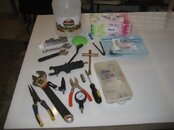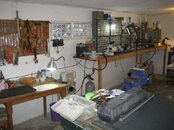A good tech should be able to do a reg in 1hr. If they take 3 hours they are fleecing you.[/B] The reg should come back with all the parts they've taken out, o-rings and HP seats. Plus a list of consumables i,e any hoses that needed replacing.]
Here a view on the tools and the testing equipment of a ‘good tech’.


He has survived the intellectual challenge of a three and a half hour Scubapro – Sherwood – Aqualung – Apeks – Oceanic or whatever Regulator Tech Clinic and is now proud owner of a Regulator Technician Certificate which hangs on the wall of his workshop.
He needs maximum 60 to 65 minutes for a complete service and testing of any given regulator type (1
st stage, 2
nd, octopus & SPG ).

His extensive experience, knowledge and expertise on regulators and regulator testing procedures makes it for him unnecessary to use test machines to control his own work others than the ones he is using anyway, his customers when they are underwater.

If he would become a ’really good tech’ he could finish a professional regulator service in 35 minutes or less, he is working on that......


This is part of the service and repair tools and test equipment of a 22 years in business amateur, who needs
minimum 2 hours for a complete service and test of a regulator (SP MKII – R295 – R190), for most SP – Aqualung – Apeks – Oceanic – Sherwood – Mares regulators he needs more time.
Seems he is fleecing one victim after another.

He has so little trust in his own work, that he has invested thousands of US$ in test equipment which hopefully detects most of the blunder he is doing during the ‘service’ before his clients do.

He conducts additionally to the normal procedures a lot of other useless tests on the regulators like the inhalation cracking tests, flow tests, water integrity and checking the dynamic IP, and does a thoroughly documentation of the process, all that just to camouflage that he has no clue what he is doing.:cool2:
He tries to impress himself and his customers with his tools and test equipment to justify his horrendous prices ( Apeks Regulator Service 90,-US$, including parts) and to compensate his strong inferior complexes.

Nevertheless until now it seems he is getting away with it

, understanding that he probably will never become a ‘good tech’.

Tel Aviv…….[SMV][/SMV]
, understanding that he probably will never become a ‘good tech’.









